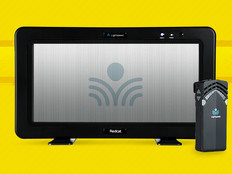Handwriting vs. Typing: Which Skill Do Students Need Most?
What if 20 years from now, writing by hand on paper is as outdated as taking a chisel and hammer to a slab of stone? It might sound unthinkable, but given the current trajectory of K-12 education, handwriting could take a backseat to typing as technology dominates the way we communicate.
As digital natives have begun to make their way through the educational system — effortlessly wielding mobile devices and navigating the web for independent research — more people have begun to wonder about the future of handwriting.
The first blow dealt by technology has been to cursive writing. Earlier this year, teacher supplies retailer Really Good Stuff released a survey that found that “41 percent of elementary school teachers no longer incorporate cursive writing instruction into their curriculum.”
While cursive has been the first pillar of student handwriting to fall, it seems likely that print handwriting will take a backseat to typing as well. That’s because the Common Core standards, which 45 states have adopted, mandate that students take online tests as part of the state’s ongoing evaluation of student performance. In fact, according to the standards, students must be proficient in typing by the time they reach the fourth grade.
This has some educators in Louisiana wondering if typing lessons shouldn’t begin in kindergarten, according to a report from NOLA.com:
Most high school and college students are expected to type, rather than handwrite, their essays. But asking students as young as eight and nine to type several paragraphs on a standardized test presents entirely new challenges.
To ward off disaster, school leaders are contemplating adding keyboarding classes, introducing online assessments in kindergarten and taking students to the computer laboratory for writing class.
Since teachers already have jam-packed schedules, if typing is introduced at an earlier age, couldn’t the focus on keyboard lessons diminish the role of handwriting overall?
After all, the prioritization of print writing versus cursive writing has been partly responsible for the latter’s demise, says Stephen Graham, a professor at Arizona State University and an authority on writing education, in an article in The Providence Journal. Graham posits that “the reason cursive is disappearing and printing is not is simply because, in the United States, printing is introduced first, so it is more convenient to keep because the youngest students already know it.”
The arguments that many educators raise in favor of handwriting education include the ability to read historic documents, such as the Constitution, which are written in cursive. Other reasons are rooted in nostalgia or current conventions that require a written signature — both things that might lose their relevance by the time today’s students reach adulthood.
Rebecca Silva, a third-grade teacher at Sowams School in Barrington, R.I., expressed such concerns to The Providence Journal. She says students will lose that personal touch to their communication if they give up handwriting. Furthermore, won’t they need to write checks?
“What are we going to do if kids can’t sign their name on a card for their parents for their birthday?” she said. “They’re not going to treasure something they’ve done in Microsoft Word.”
…
“Obviously, kids need to be able to handwrite things and sign a check if they’re going to pay for things the good old-fashioned way,” she said. “They will need to sign for a driver’s license and things like that.”
But payments by mobile phone are on the rise, and paper checks will likely see a steep decline, if not outright extinction, in the next few decades. If paper mail is having trouble competing with email, you can bet the same will be true of paper payments versus electronic payments.
In fact, technology is moving at such a rapid pace that even keyboards themselves are in danger. A recent Gartner survey said that tablets will make up half of all first-time computer purchases by 2017, which means many children may not even use a physical keyboard.
Is your school making plans to introducing typing? How are you prioritizing handwriting versus typing? Let us know in the comments section.







